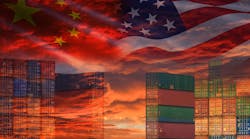After a year of uncertainty over the trade wars, 2019 closed out on a slightly positive note for U.S. companies that were seeking some relief from the international tariffs that hit their supply chains during the prior 12 months.
In December, President Trump agreed to a limited trade agreement with China that will cancel tariffs set to take effect and roll back existing levies on Chinese goods. The WSJ reported that the agreement also secures Chinese purchases of U.S. farm goods.
In the absence of last-minute problems, the primary impact for U.S. importers and exporters will be a more stable business environment as they prepare new orders for 2020, WSJ’s Paul Page reports, noting that the deal calls for China to buy $50 billion worth of agricultural products in 2020, along with energy and other goods. “That’s far more than China has ever bought in the past, marking a big win for U.S. farmers if the orders come through,” Page writes.
At press time, Chinese leader Xi Jinping was calling this phase one trade deal beneficial to both China and the U.S., CNBC reported. “The first-phase economic and trade agreement reached between the U.S. and China is a good thing for the U.S., China, and the entire world,” Xi said. “Both the U.S. and Chinese markets and the world have responded very positively to this. The U.S. is willing to maintain close communication with China and strive to sign and implement it as soon as possible.”
For this deal, the U.S. will be maintaining 25% tariffs on approximately $250 billion worth of Chinese imports while reducing tariffs on $120 billion worth of goods to 7.5%. CNBC also says that this “phase one” agreement struck between the U.S. and China includes a commitment by Beijing to make “substantial” purchases of American goods in coming years.
Gradual Elimination Ahead?
Here’s the bigger news: The plan is to gradually eliminate tariffs on Chinese goods in phases, USA Today reports. According to Wang Shouwen, China’s vice commerce minister, the mini-deal represents significant progress in ending the 17-month-old U.S.-Chinese trade war, and will create better conditions between the two countries, the publication adds.
A few days after the two countries announced the phase one trade deal, China unveiled a new list of import tariff exemptions for six chemical and oil products from the United States. The exemptions will be for one year from Dec. 26, CNBC reports.
The tariff waivers will apply to four chemical products, including metallocene high-density polyethylene (HDPE) and a special grade of linear low-density polyethylene (LLDPE), and refined oil products that include white oil and food-grade petroleum wax.
The exemptions on the chemical products could benefit companies such as Dow Chemical, Exxon Mobil, and Chevron Phillips Chemical, according to CBNC, and could see China resume buying more HDPE and LLDPE from the U.S., reversing the trade flow.
“The Sino-U.S. trade war has been a major headache for global policymakers as it slowed economic growth worldwide and chilled business investment and confidence,” CNBC adds, noting that there is no specific timetable for these tariff rollbacks.
We Want More
Some industries applauded the positive news, but also asked for more of it in the future. “While this is a step in the right direction, it means American businesses, American consumers, and American workers are still being hammered at an unacceptably high level by tariffs imposed on U.S. imports from China, and in retaliation, by China’s imports from the U.S.” Rick Helfenbein, president and CEO of the American Apparel & Footwear Association, said in a statement.
“The administration has imposed one of the largest consumer and manufacturing taxes in American history, most of which remains in place following this agreement,” he continued. “Rising costs are already working their way through supply chains and they will still have a negative impact going into next year.”
Retail trade organizations also praised the progress while pushing for a rollback of all tariffs, RetailWire reports. “Critics see tariffs raising prices for consumers and undermining long-term planning,” the publication points out. “For instance, while some suppliers have significantly reduced their exposure to China, a fear is that new tariffs will be placed on countries they’ve shifted to.”
As we move into 2020, several uncertainties could impact the tariff situation. Not only are more U.S. companies voicing their concerns over the trade war impacts, but it’s also an election year. With the U.S. economy still in full swing and showing no solid signs of slowing down just yet, both manufacturers and distributors should keep an eye on these developments.










